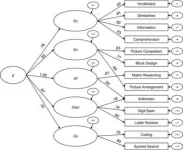EgalitarianJay
Member
- Joined
- May 5, 2012
- Messages
- 120
- Reaction score
- 31
- Gender
- Male
- Political Leaning
- Liberal

I came to this board while searching the internet for forums where posters support Scientific Racism. I use the term Scientific Racism because that is the labeling commonly used in academia to describe the research of scholars who claim to have evidence that there are innate racial differences in mental ability. Such scholars and advocates of the position are commonly called racialists.
The term race-realism is far too presumptuous. That term implies that racialist claims are in fact the truth and I believe that is a claim that should be settled by drawing conclusions from facts rather than assuming a claim is fact.
Racism is an accurate description of this research going by the traditional definition of the word e.g. hatred or intolerance based on race or discrimination based on racialism (racism is a term originally used to describe the racial theories of Nazi Germany). Racialists claim that racialist research is conducted in order to seek the truth but what is the goal? In my experience every racialist who has advocated belief in such views has stated that their conclusions validate policy recommendations such as racial separation which is undeniably a racist policy.
During my personal research into this issue I have discovered a common position that nearly all critics of Scientific Racism share. Their position is that this research is NOT science. It is pseudoscience or fake science. Now who is to say what is real science? We can identify real scientific research by determining that the methodology of the researcher follows the scientific method. Science is knowledge of facts gained by systematic observation of experimentation. The Scientific Method is a valid direction to take when conducting a scientific investigation. Pseudoscience is any research that is claimed to be science but does not follow the scientific method.
Here is the difference....
Science
1. Gather facts.
2. Come up with a hypothesis to make sense of them.
3. Test the hypothesis.
Pseudoscience
1. Come up with the desired conclusion.
2. Gather facts that support the conclusion.
3. Find excuses for the facts that do not fit.
Race-Realism is heavily based on the research of Psychologists who conduct tests designed to measure a person's mental ability. This field of research is known as Psychometrics and the standard form of mental testing applied by scholars in this field are called IQ tests (IQ = Intelligence Quotient). There are a handful of Psychometricians who study the IQ averages on groups such as races, genders and social classes and have come to the conclusion that differences in IQ score between these groups has a hereditary component.
Advocates of this position are commonly called hereditarians. Racial hereditarians believe that the cause of racial differences in IQ score are partially due to genetic differences between races. Additionally many racial hereditarians claim that differences in IQ score between races correlate with academic success and standard of living, life style choices and behavior.
Because the races allegedly differ in a number of Socioeconomic conditions differences in intelligence and personality that impacts behavior are alleged by racial hereditarians to be the cause of these Socioeconomic conditions.
So if members of a race generally performs less well in school or are more poor or commit more crime on average than other races then the reason for this is because that race is less intelligent or have lower morals because of genetic differences. These conclusions have serious implications for society at large. Racial hereditarians often caution that they are only talking about averages not absolutes. Their generalizations do not apply to all individuals of a race just the tendencies of a collective and that environment is a partial cause for the statistics they cite. Nonetheless they are claiming that certain races are innately dumber, more violent and even less sexually restrained than other races.
These conclusions have implications not only for the research of Psychologists but many other fields including genetics, biology, anthropology and sociology. It is from many of these other fields in addition to Psychologists that racial hereditarians received a lot of their academic criticism. I have read the research of many scholars both proponents of racialism and critics a like. The research I find most interesting is the work of J Philippe Rushton and Joseph L Graves.
Rushton is a Psychologist who has attempted to prove the hereditarian position on racial differences in IQ to be valid based on evolutionary science.
Graves is an evolutionary biologist who has done a lot of research on racial theories as well as critiqued the hereditarian position on Race and IQ as well as Rushton's evolutionary arguments on race specifically. On the subject of evolution and genetics Graves is qualified to speak with authority on the subject while Rushton is a researcher in a different field making claims about evolution that he believes support his conclusions on Race and IQ.
Within his critique of Rushton's own research Graves has identified a syllogism common to all hereditarian researchers:
1. General intelligence can be quantified by a single metric known as g.
2. Standardized tests can be utilized to measure g.
3. g is mostly genetically determined.
4. Races differ consistently in their performance on intelligence tests.
5. This difference must in part be due to the genetic differences between races.
6. Races of human being can be unambiguously defined by biological means.
Source: The Misuse of Life History Theory: J. P. Rushton and the Pseudoscience of Racial Hierarchy In Race and Intelligence: Separating Science from Myth, edited by J. Fish. Mahwah, NJ: Lawrence Erlbaum, 57-94.
Here are the problems Graves finds with the research of hereditarians in general:
1. They make claims that are not supported by the data given
2. They make errors in calculation that invariably support their hypothesis
3. There's no mention of data that contradicts their hypothesis
4. There's no mention of theories and data that conflict with core assumptions
5. They make bold policy recommendations that are consistent with those advocated by racists.
Source: The Emperor's New Clothes: Biological Theories of Race at the Millennium p. 8
In other words hereditarian research violates the Scientific Method in numerous ways most notably through confirmation bias, omission and error.
In his work Graves lists numerous examples of the unscientific methodology employed by racialists.
Here is a summary of some of the problems:
Joseph Graves said:A CRITICAL TEST OF THE GENETIC BASIS OF g: AN EXPERIMENTAL APPROACH
Despite the psychometricians' inflated claims about the genetic basis of intelligence, almost none of them have any real or practical knowledge of experimental quantitative genetics. Parroting evolutionary and ecological concepts, many of them apply these paradigms uncritically as they search for simplistic explanations for extremely complicated aspects of human society (Graves & Place, 1995). The proper utilization of core evolutionary and quantitative techniques would shatter the psychometricians' program. For example, efforts to test g experimentally would be rife with difficulties-of course, that could explain why the psychometricians avoid such a critical test. Additionally, there are several other alternative hypotheses concerning generalized intellectual ability the psychometricians have yet to test.
Source: The Pseudoscience of Psychometry and The Bell Curve The Journal of Negro Education, Vol. 64, No. 3, Myths and Realities: African Americans and the Measurement of Human Abilities (Summer, 1995), pp. 277-294
Rushton himself is one of the scholars most known for using evolutionary and ecological concepts to explain how he believes genetic differences between races that impact intelligence and behavior came about. Rushton presented all of this evolutionary research in his book Race, Evolution and Behavior. The book received criticism from several scholars including Graves. Graves himself debated Rushton at a panel discussion where they and other scholars presented their positions on the race and IQ controversy.
You can watch the video of that presentation here:
It is noteworthy that Rushton never responded to Graves critique in print. His research is the most often cited by other psychometricians and other proponents of racial hereditarianism yet he cannot defend his research against an expert in the field. This supports Graves position that hereditarians in addition to all the errors within their work are not willing or able to put their theories to a meaningful test.
Racialist research is pseudoscience and has been debunked.








